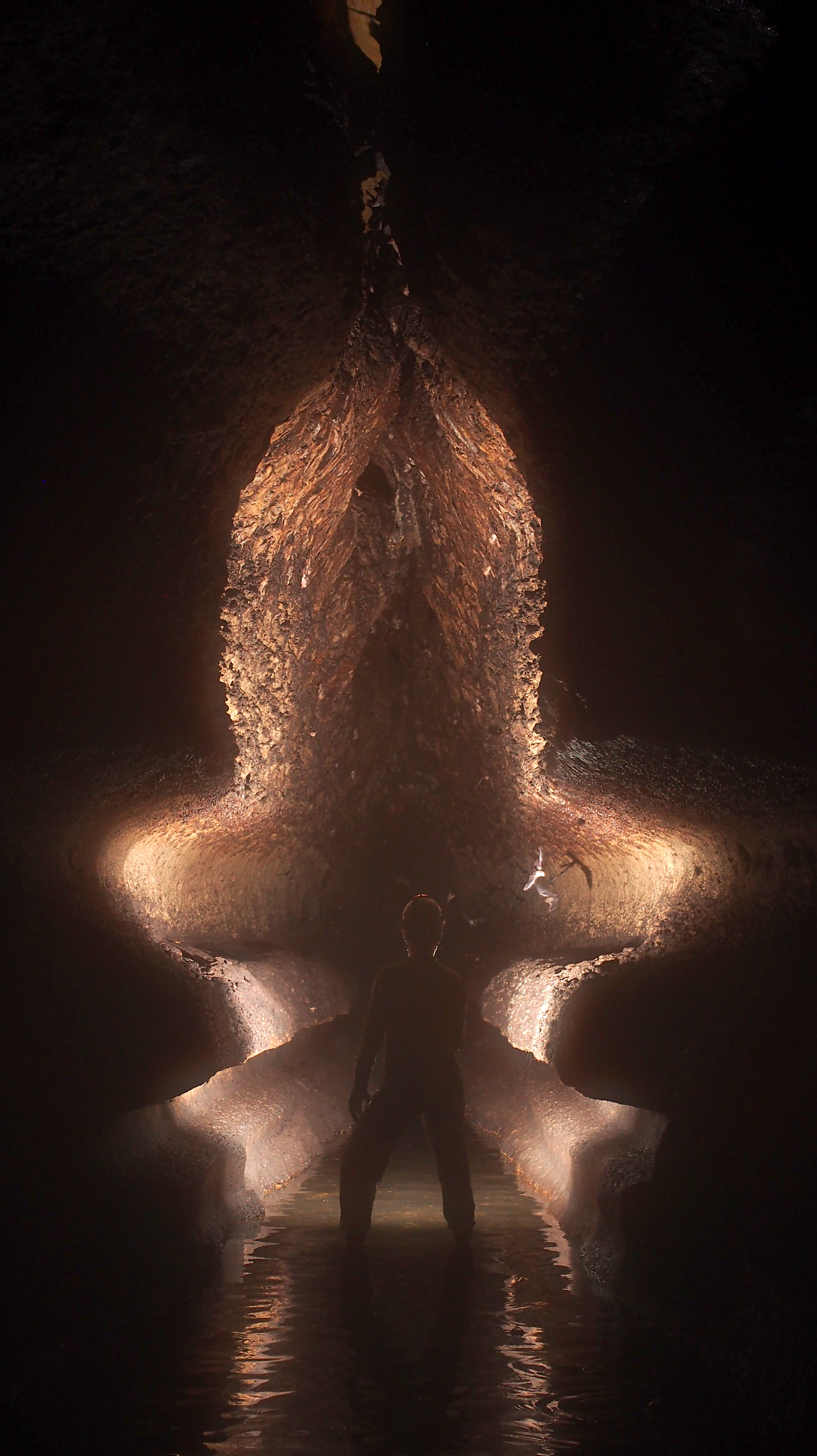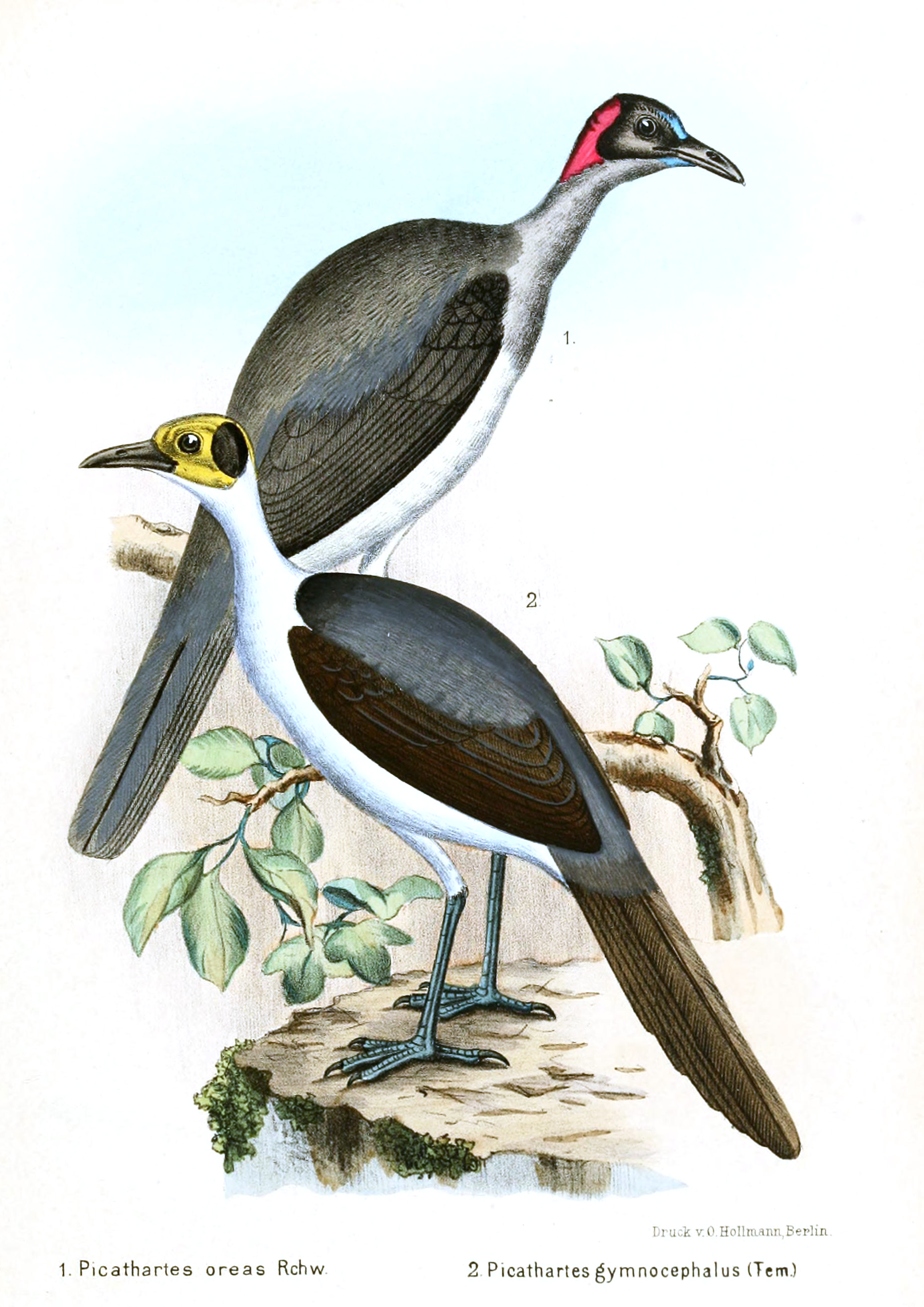|
Abanda Caves
The Abanda Caves are a cave complex in Gabon, located in the upstream of Fernan Vaz Lagoon. They were first mentioned by Dr. Marco Marti and Claude Werotte in the early 2000s, and fully explored during several caving expeditions by Oslisly, Testa, Sebag and Shirley. There are two independent cave networks: the Dinguembou cave (350m) and the Mugumbi cave (400m). Access to the horizontal passages is possible through vertical shafts of about 7m deep. They host large colonies of bats (Egyptian fruit bat, Sundevall's roundleaf bat, Giant roundleaf bat) estimated to more than 100,000 individuals. Picathartes nests have been observed at the entrances of the caves. The Caves of Abanda are known to host an endemic population of orange-colored cave-dwelling dwarf crocodiles. They were described by herpetologist Matthew H. Shirley after the first scientific expedition in the caves in 2010. These crocodiles live in complete darkness, they feed mostly on bats and cave crickets and swim in li ... [...More Info...] [...Related Items...] OR: [Wikipedia] [Google] [Baidu] |
Gabon
Gabon (; ; snq, Ngabu), officially the Gabonese Republic (french: République gabonaise), is a country on the west coast of Central Africa. Located on the equator, it is bordered by Equatorial Guinea to the northwest, Cameroon to the north, the Republic of the Congo on the east and south, and the Gulf of Guinea to the west. It has an area of nearly and its population is estimated at million people. There are coastal plains, mountains (the Cristal Mountains and the Chaillu Massif in the centre), and a savanna in the east. Since its independence from France in 1960, the sovereign state of Gabon has had three presidents. In the 1990s, it introduced a multi-party system and a democratic constitution that aimed for a more transparent electoral process and reformed some governmental institutions. With petroleum and foreign private investment, it has the fourth highest HDI in the region (after Mauritius, Seychelles and South Africa) and the fifth highest GDP per capita (PPP) i ... [...More Info...] [...Related Items...] OR: [Wikipedia] [Google] [Baidu] |
Fernan Vaz Lagoon
Fernan Vaz Lagoon is a large lagoon on the Atlantic coast of Gabon. It is named for Fernão Vaz, the first European to reach it, and is known its wildlife and for the church at Mission Saint Anne, built in 1889 by Gustav Eiffel Alexandre Gustave Eiffel (born Bonickhausen dit Eiffel; ; ; 15 December 1832 – 27 December 1923) was a French civil engineer. A graduate of École Centrale des Arts et Manufactures, he made his name with various bridges for the French railway .... The main settlement on the lagoon's shore is Omboué. Lagoons of Gabon {{Gabon-geo-stub ... [...More Info...] [...Related Items...] OR: [Wikipedia] [Google] [Baidu] |
Olivier Testa
Olivier Testa (born April 1, 1977) is a cave explorer, known for his discovery of the orange cave-dwelling crocodiles of Gabon, the Iroungou burial cave in Gabon, the discovery of unexpected caves in the volcanic Bamboutos mountains in Cameroon and several discoveries in Haiti. He has led or participated in over 40 caving expeditions in Africa, Asia and in the Caribbean. Early life Testa was born in Marseille, France, and grew up in the Alps, in Annecy, France, where he learnt mountain sports. After obtaining an engineer's degree at École Centrale Paris in 2000, Testa tried different jobs and worked 2 years at French Institute for Research in Computer Science and Automation (INRIA) ( Real-Time Scheduling), near Grenoble, France, from 2001 to 2003. Meanwhile, he was an active caver at the La Tronche caving club (FLT). He explored and practiced in many deep caves in Chartreuse Mountains and Vercors Massif, and started cave diving. Testa discovered Africa volunteering f ... [...More Info...] [...Related Items...] OR: [Wikipedia] [Google] [Baidu] |
Egyptian Fruit Bat
The Egyptian fruit bat or Egyptian rousette (''Rousettus aegyptiacus'') is a species of megabat that is found in Africa, the Middle East, the Mediterranean, and the Indian subcontinent. It is one of three ''Rousettus'' species with an African-Malagasy range, though the only species of its genus found on continental Africa. The common ancestor of the three species colonized the region in the late Pliocene or early Pleistocene. The species is traditionally divided into six subspecies. It is considered a medium-sized megabat, with adults weighing and possessing wingspans of approximately . Individuals are dark brown or grayish brown, with their undersides paler than their backs. The Egyptian fruit bat is a highly social species, usually living in colonies with thousands of other bats. It, along with other members of the genus ''Rousettus'', are some of the only fruit bats to use echolocation, though a more primitive version than used by bats in other families. It has also develope ... [...More Info...] [...Related Items...] OR: [Wikipedia] [Google] [Baidu] |
Sundevall's Roundleaf Bat
Sundevall's roundleaf bat (''Hipposideros caffer''), also called Sundevall's leaf-nosed bat, is a species of bat in the family Hipposideridae. These bats are very similar in appearance to the closely related Noack's roundleaf bat, and the two have in the past been considered to be the same species. Although more recent research suggests that they are distinct, taken together, they possibly represent a species group containing a number of cryptic species or subspecies that have yet to be distinguished.Vallo, P., A. Guillén-Servent, P. Benda, D. Pires and P. Koubek (2008). "Variation of mitochondrial DNA in the ''Hipposideros caffer'' complex (Chiroptera: Hipposideridae) and its taxonomic implications." Acta Chiropterologica 10(2): 193-206. Description Sundevall's roundleaf bat is a medium-sized bat, with a head-body length of , and a wingspan of . Adults have a body weight of . They have long fur, which may be either grey or a bright golden-orange in colour, and brown wings. The f ... [...More Info...] [...Related Items...] OR: [Wikipedia] [Google] [Baidu] |
Giant Roundleaf Bat
The giant roundleaf bat (''Macronycteris gigas'') is a species of bat in the family Hipposideridae found in western tropical Africa. Its natural habitats are subtropical or tropical moist lowland forests and caves. The species was formerly considered part of '' M. commersoni'', which is now viewed as being restricted to Madagascar. Both ''commersoni'' and it were formerly placed in the genus ''Hipposideros'', but moved to the resurrected '' Macronycteris'' in 2017 on the basis of molecular evidence. It is threatened by habitat loss Habitat destruction (also termed habitat loss and habitat reduction) is the process by which a natural habitat becomes incapable of supporting its native species. The organisms that previously inhabited the site are displaced or dead, thereby .... References Hipposideros Mammals described in 1845 Taxonomy articles created by Polbot Taxa named by Johann Andreas Wagner Bats of Africa {{Hipposideridae-stub ... [...More Info...] [...Related Items...] OR: [Wikipedia] [Google] [Baidu] |
Picathartes
The picathartes, rockfowl, or bald crows are a small genus of two passerine bird species forming the family Picathartidae found in the rain-forests of tropical west and central Africa. They have unfeathered heads, and feed on insects and invertebrates picked from damp rocky areas. Both species are totally non-migratory, being dependent on a specialised rocky jungle habitat. Both species are listed as vulnerable to extinction on the IUCN Red List. Taxonomy and systematics The taxonomic position of the clade and its two species has been confusing. At various times, it has been grouped with the babblers, flycatchers, starlings, crows and others before being placed in a family of its own. Serle in 1952 thought it resembled the Asian genus '' Eupetes'' while Sibley used egg-albumin protein similarity, determined by electrophoresis, to suggest that it belonged to the Timaliidae. Olson revived the idea that it was related to ''Eupetes'' in 1979. A molecular sequence based study su ... [...More Info...] [...Related Items...] OR: [Wikipedia] [Google] [Baidu] |
Dwarf Crocodile
The dwarf crocodile (''Osteolaemus tetraspis''), also known as the African dwarf crocodile, broad-snouted crocodile (a name more often used for the Asian mugger crocodile) or bony crocodile, is an African crocodile that is also the smallest extant (living) species of crocodile. Taxonomy and etymology The second species has had a somewhat convoluted taxonomical history. It was first described as ''Osteoblepharon osborni'' by Schmidt in 1919, based on a few specimens from the Upper Congo River Basin in what is now the Democratic Republic of Congo. However, Inger in a 1948 paper found the specimens wanting of characteristics that would justify a generic separation from ''Osteolaemus'' and referred the specimens to '' Osteolaemus osborni''. In 1961, it was reduced to subspecies rank. A study of morphology published in 2007, and studies of DNA in 2009, 2013 and 2015 indicate that three distinctly different populations of ''Osteolaemus'' may merit full species recognition. These are ... [...More Info...] [...Related Items...] OR: [Wikipedia] [Google] [Baidu] |
Herpetologist
Herpetology (from Greek ἑρπετόν ''herpetón'', meaning "reptile" or "creeping animal") is the branch of zoology concerned with the study of amphibians (including frogs, toads, salamanders, newts, and caecilians (gymnophiona)) and reptiles (including snakes, lizards, amphisbaenids, turtles, terrapins, tortoises, crocodilians, and the tuataras). Birds, which are cladistically included within Reptilia, are traditionally excluded here; the scientific study of birds is the subject of ornithology. Thus, the definition of herpetology can be more precisely stated as the study of ectothermic (cold-blooded) tetrapods. Under this definition "herps" (or sometimes "herptiles" or "herpetofauna") exclude fish, but it is not uncommon for herpetological and ichthyological scientific societies to collaborate. Examples include publishing joint journals and holding conferences in order to foster the exchange of ideas between the fields, as the American Society of Ichthyologists and He ... [...More Info...] [...Related Items...] OR: [Wikipedia] [Google] [Baidu] |
Cave Crickets
The orthopteran family Rhaphidophoridae of the suborder Ensifera has a worldwide distribution. Common names for these insects include cave wētā, cave crickets, camelback crickets, camel crickets, Hogan bugs, spider crickets (sometimes shortened to "criders", or "land shrimp" or "sprickets",) and sand treaders. Those occurring in New Zealand, Australia, and Tasmania are typically referred to as jumping or cave wētā. Most are found in forest environments or within caves, animal burrows, cellars, under stones, or in wood or similar environments. All species are flightless and nocturnal, usually with long antennae and legs. More than 500 species of Rhaphidophoridae are described. The well-known field crickets are from a different superfamily (Grylloidea) and only look vaguely similar, while members of the family Tettigoniidae may look superficially similar in body form. Description Most cave crickets have very large hind legs with "drumstick-shaped" femora and equally long, t ... [...More Info...] [...Related Items...] OR: [Wikipedia] [Google] [Baidu] |
Guano
Guano (Spanish from qu, wanu) is the accumulated excrement of seabirds or bats. As a manure, guano is a highly effective fertilizer due to the high content of nitrogen, phosphate, and potassium, all key nutrients essential for plant growth. Guano was also, to a lesser extent, sought for the production of gunpowder and other explosive materials. The 19th-century seabird guano trade played a pivotal role in the development of modern input-intensive farming. The demand for guano spurred the human colonization of remote bird islands in many parts of the world. Unsustainable seabird guano mining processes can result in permanent habitat destruction and the loss of millions of seabirds. Bat guano is found in caves throughout the world. Many cave ecosystems are wholly dependent on bats to provide nutrients via their guano which supports bacteria, fungi, invertebrates, and vertebrates. The loss of bats from a cave can result in the extinction of species that rely on their guano. U ... [...More Info...] [...Related Items...] OR: [Wikipedia] [Google] [Baidu] |






